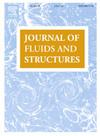结构系统流固耦合动力学模型的凝结解法
IF 3.4
2区 工程技术
Q1 ENGINEERING, MECHANICAL
引用次数: 0
摘要
在流体-结构动力学分析中,低求解效率严重制约了结构的被动和主动振动控制。但迄今为止,这一问题尚未得到很好的解决。构件模态合成(CMS)是一种高效的结构动态分析方法。然而,由于流体的模态概念非常薄弱,CMS 并不适用于解决流固耦合动力学问题。另一种降维方法是源于 Guyan 方法的动态凝聚法。本文引入 CMS 的思想,结合 Guyan 方法,提出了一种高效的凝缩求解方法来求解流固耦合动力学模型。在动力学模型中,结构场和流体场均采用 20 节点三维元素离散化。利用汉密尔顿原理和加权残差法制定了元素流固相互作用运动方程。将固体场和流体场划分为子结构,并将两个场的所有自由度(DOFs)划分为内部结构 DOFs、边界结构 DOFs、内部主流体 DOFs、内部主流体 DOFs 以及边界流体 DOFs。在固体子结构中,忽略了高阶模,以实现大规模降维;而在流体场中,用主 DOF 代替从 DOF。为了对本方法进行验证,我们进行了实验。对比结果表明,冷凝求解法具有较高的精度和效率。本文章由计算机程序翻译,如有差异,请以英文原文为准。
Condensation solution method for fluid-structure interaction dynamic models of structural system
In the fluid-structure dynamic analysis, the low solution efficiency seriously restricts the passive and active vibration control of structures. But so far, this issue has not been well addressed. Component mode synthesis (CMS) is an efficient method for dynamic analysis of structures. However, since the concept of mode for the fluid is very weak, the CMS is not suitable for solving fluid-structure interaction dynamic problems. Another type of dimension reduction method is dynamic condensation originating from Guyan method. In this paper, introducing the idea of CMS and combining the Guyan method, an efficient condensation solution method is proposed to solve the fluid-structure interaction dynamic models. In the dynamical modeling, both the structure field and fluid field are discretized using 20-node three dimensional elements. The elemental fluid-structure interaction equations of motion are formulated using the Hamilton principle and weighted residual method. The solid and fluid fields are divided into substructures, and all the degrees of freedom (DOFs) of the two fields are divided into interior structure DOFs, boundary structure DOFs, interior master fluid DOFs, interior salve fluid DOFs, as well as boundary fluid DOFs. In the solid substructures, higher orders of mode are neglected to realize a large-scale dimensional reduction, while for the fluid field, the slave DOFs are replaced by the master DOFs. To conduct the verification of the present method, experiment is carried out. The comparison results show the high accuracy and efficiency of the condensation solution method.
求助全文
通过发布文献求助,成功后即可免费获取论文全文。
去求助
来源期刊

Journal of Fluids and Structures
工程技术-工程:机械
CiteScore
6.90
自引率
8.30%
发文量
173
审稿时长
65 days
期刊介绍:
The Journal of Fluids and Structures serves as a focal point and a forum for the exchange of ideas, for the many kinds of specialists and practitioners concerned with fluid–structure interactions and the dynamics of systems related thereto, in any field. One of its aims is to foster the cross–fertilization of ideas, methods and techniques in the various disciplines involved.
The journal publishes papers that present original and significant contributions on all aspects of the mechanical interactions between fluids and solids, regardless of scale.
 求助内容:
求助内容: 应助结果提醒方式:
应助结果提醒方式:


